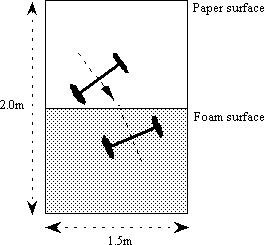 What it shows:
What it shows:
A mechanical analogy of a wave front consisting of two wheels linked by an axle. It simulates refraction by rolling across a boundary between two surfaces having different rolling friction and thus altered propagation velocities.
How it works:
The media through which the wave moves consists of a 2m × 1.5m plywood sheet. The medium with low refractive index is paper (bare board is fine but aesthetically ugly), while the high n medium is 1/4" thick foam rubber. The wave front consists of two caster wheels linked by a 50cm dowel axle; the wheels are analogous to the wavelets, while the axle mimics the wave front. Rolling the wave front across the paper and onto the foam at an angle (as in figure 1) means that one wheel encounters the spongy ground first and due to friction, slows. This has the effect of rotating the axle direction. In the wavelet picture of light, the wavelet that strikes the high n medium first has its propagation velocity reduced, so refracting the wave front.
Setting it up:
The board needs to rest sloping at about 20° to the horizontal with the foam end at the bottom. The board is probably too cumbersome to flip round during lecture.
Comments:
The effect works best when rolling from the paper surface to the foam, and is most consistent with an angle of incidence of between 30° to 40°. We've seen this demo work better on a smaller scale, but that's no good to the near-sighted student in the back row.